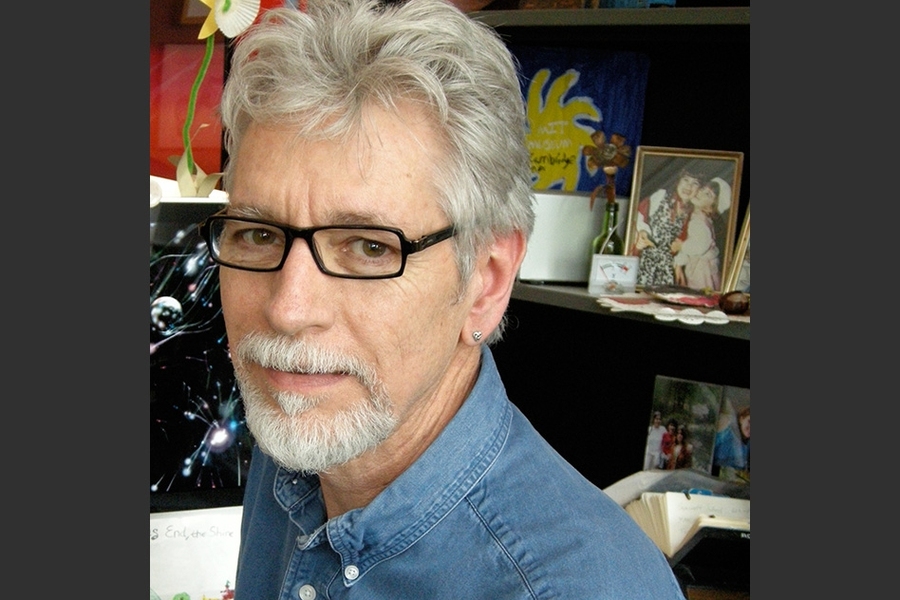Donald Stidsen, the longtime exhibitions manager at the MIT Museum, died last Wednesday, Oct. 28, while driving to work with his wife, Kate McHugh.
"Don was valued for his expertise in lighting, color, framing, and in fabricating, building, hanging, and installing exhibitions," says John Durant, director of the MIT Museum. Along with others, Stidsen was honored with an Infinite Mile Award in 2011 for his role in mounting the museum’s exhibition to mark MIT’s 150th anniversary. His many colleagues and friends depended on him, however, not just for his vast artistic knowledge, but especially for his kindness, his humor, and his style, Durant says.
“In many ways,” Durant adds, “Don Stidsen was the MIT Museum: He was the longest-serving staff member we’ve ever had; and he saw the museum through any number of changes and developments. He represented the artisanal, ‘get-the-job-done’ tradition of museum professionalism, and his wide-ranging skills served both his colleagues and the museum’s visitors extremely well over the greater part of the museum’s history to date.”
Stidsen came to the MIT Museum as one of its earliest employees, in 1982, after working at the Erie Canal Museum in Syracuse, New York, and the Dickson Mounds Museum, a branch of the Illinois State Museum, in Lewistown, Illinois. He held a BFA from the University of Massachusetts at Dartmouth in visual design, and a master’s degree in public visual communications from Southern Illinois University, Carbondale.
During his 33-year career at MIT, Stidsen either installed or supervised over 300 MIT Museum exhibitions and displays, many illuminating the work of renowned artists, engineers, and designers, as well MIT faculty and students. Whether framing works by Ansel Adams or Berenice Abbott or helping other departments at MIT — and on occasion, at Harvard University, Harvard Business School, and the Waterworks Museum in Chestnut Hill — to create or hang exhibitions, Stidsen provided an exceptional level of care, professionalism, and expertise.
“He would spend hours studying photographs as he prepared to frame and hang them,” says Deborah Douglas, the museum’s director of collections. “He was simply the best lighting designer I have ever known, and likely will ever work with. With the flick of his wrist he could create a dramatic impact that I would never have thought about, much less thought possible.”
“The Compton Gallery and the Kurtz Gallery for Photography were amongst his favorite museum spaces, and were showcases for his great skill at two-dimensional installations,” Gary Van Zante, the museum’s curator of architecture and design, says.
Stidsen also worked closely with kinetic artist Arthur Ganson, whose sculptures have long been on display at the MIT Museum, says Mary Leen, the museum’s associate director. “Additionally, Don was one of the few people in the country with expertise in the critical aspect of lighting holograms for viewing in a museum setting,” Leen says.
“Creative, smart, dedicated, patient, and cool-headed in the chaos of an exhibition installation, he was a particular master of color and light,” Douglas adds, noting that Stidsen worked with dozens of aspiring young artists and exhibitions professionals over the years.
Stidsen was a collaborator, and turned concepts into beautiful spaces where the public could reflect and enjoy learning. Lora Dunn-Hardy, who recently started working for Stidsen, says that he was, “a listener, a creator, a teacher, a mentor, an artist, and a friend.”
Stidsen also raised the visibility of children’s work, managing the exhibitions of the annual children’s drawing contest at MIT Medical; displaying woodworking projects by local elementary students at the museum; and archiving thousands of pictures of robots drawn by young museum visitors.
Ben Wiehe, manager of the Science Festival Alliance at the museum, says he found Stidsen to be eminently approachable when the two became colleagues a few years ago.
“He was just this cool person — he worked late into the night with Celtic music on, and the lights low in his office,” Wiehe says. “Sometimes, if you walked by you would see him perched on his stool, the tools of his trade scattered about: levels with particular markings, rulers and pencils, books piled high — plants, posters, coffee cups, and family photographs everywhere. For that moment you just wanted to be him, intent on his work, surrounded by all that he loved.”
“Don’s death has come as a tremendous shock to us all,” Durant says. “He will be sorely missed by both his colleagues and his many friends here at MIT.”
In addition to his wife, Kate McHugh, of Andover, Stidsen is survived by twin daughters, Hannah and Lizzie Stidsen. He often said that his greatest accomplishment was a life-saving organ donation to his daughter in 2006. Following his daughter’s illness, Stidsen and his family became involved as annual volunteers at Camp Sunshine, a retreat for children with life-threatening diseases and their families in Casco, Maine. Gifts in Stidsen’s memory may be made to Camp Sunshine.
A memorial service is scheduled for Saturday, Nov. 14, at 11:00 a.m. at the North Parish Unitarian Universalist Church, 190 Academy Road, North Andover, Massachusetts.






